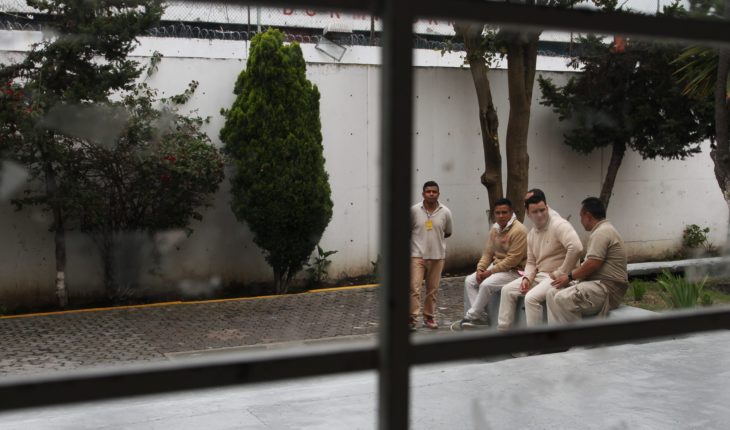Over the past four years, overcrowding of prisons has ceased to be a common denominator in the country. While in 2014 there were 24 states with more in-house sits than spaces available at their local inmates, by 2019 the figure was reduced to 11 states with this problem.
And in federal prisons, the percentage of occupation declined to the point where more than half of their available spaces are now free.
This reduction coincides with the entry into force of the new criminal prosecution system which, as published on Monday, eliminated automatic pre-trial detention in most crimes, which together with other factors contributed to the current nearly 60,000 people in confinement less than four years ago. It is a reduction of a quarter of the entire prison population.
Read: Send AMLO to the criminal coordinator to lead the Migration Institute
The official data of the Deconcentrated Administrative Body for Prevention and Social Rehabilitation (OADPRS) obtained by Political Animal transparency shows that, in 2014, there was an overpopulation problem in 3 out of 4 states. In some entities such as the state of Mexico, Nayarit and Hidalgo, the population nearly tripled the available spaces, while in others such as Mexico City it was nearly double.
By 2019, however, only 11 states continue to report a prison population higher than the capacity of their local inmates. These include Nayarit, Quintana Roo, Jalisco, Puebla, Guerrero, Tabasco, Morelos, Hidalgo, Chihuahua, Durango and the State of Mexico.
Among the states that recorded a further decline in their prison population in this period is Colima, Chiapas and Sinaloa, with drops of 40 to 60% in their total number of inmates. In absolute numbers Mexico City is the entity with the largest reduction in in in number of inmates: almost 15 thousand less.
Fewer alleged culprits… except in CDMX
In 2014, 42% of the domestic inmates in the country were people who remained under process without even proven guilt, while the remaining 58% were sentenced interns. By 2019 the percentage of inmates preventively fell to 38% compared to the total, while that of sentenced inmates rose to 62%.
Read: Recovering their lives without stigmas, the goal of ex-inmates after serving prison sentences
This confirms the warning by a number of experts that the decline in the total prison population is largely due to the difficulty of pre-trial detention of more people under the new system, which has reduced entry of alleged culprits into prisons. In addition to this, the departure of people serving their sentences is the consequence of a rapid decline in the prison population.
Analyzing this at the state level confirms the phenomenon, although not in all cases.
For example, Colima, the entity with the largest fall in its prison population in this period: almost 61% of all its inmates. There the number of sentenced ins just fell 30.4%, while the number of alleged culprits without a sentence fell 75.5%. In other words, this is a much larger reduction in the universe of people on remand.
In Chiapas, the second entity with the largest reduction in its prison population, the situation is more even: both the universe of sentenced inmates and that of defendants is almost halved. But in Sinaloa, the third state with the greatest decline, the proportion returns to be as in Colima: inmates on remand were reduced by 55%, while those sentenced 32.1%.
The exception is Mexico City. Here the number of sentenced insjustes rose from 33 thousand 976 in 2014 to 21 thousand 394 in 2019, which equates to a fall of 43.2%. Meanwhile, the under-process inmate population decreased from 5,000 to 4,276, just 18%.
While there are 11 states that this 2019 still continue to overpopulate, eight of them decreased the problem. One of the clearest cases is Nayarit where the percentage of overcrowding rose from 240% in 2014 to 170% in 2019.
There are only five states of the country where the number of inmates has increased in the last five years: Chihuahua, Durando, State of Mexico (all with overpopulation problems) as well as Guanajuato and Zacatecas.
Federal penalties, not halfway
As with state prisons, the population in federal prisons has declined considerably. While 24,776 inmates were reported in these high-security and maximum-security prisons in 2014, the figure fell by 17,668 by 2019, which is almost 30 per cent.
And similar to what happens in states, the population decline in these federal inmates has been strongly driven by the departure of inmates who are suspected culprits without sentencing. That universe was reduced by 43.2%. While the number of sentenced inmates dropped by 11.5%.
Read: Topo Boy, one of the prisons with the most conflicts and riots will now be a park
In recent years the government invested in the expansion of the spaces in the federal prisons, increasing from 31 thousand to more than 38 thousand the places available in them.
However, with the decline in the population in federal inmates, today it is noted that they are occupied by only 46%. That is, more than half of the spaces on federal prisons are unoccupied.
Depressurization, progress in human rights
Stanford University’s PhD and researcher in CIDE’s Division of Legal Studies, Catalina Pérez Correa, said that depressurization of the prison system is a breakthrough in several areas. One of them is the presumption of innocence and respect for human rights, especially in the case of persons who without sent prison.
“In terms of respect for human rights, having people in Mexican prisons is a risk, because of the lack of health service, the violence that is experienced there, the misrule, the lack of work, etc.”
But Pérez Correa also warns of advantages in economic terms, since to a large extent there were many people who were previously sent to prison on a bond that they could not cover, which meant that they were imprisoned not because of a matter of danger but of lack of money . This, in turn, resulted in a maintenance cost for the State that was avoidable.
“In addition to the economic cost to the state of having these people in prison, which is likely to exceed the cost of the economic damage they have caused, the social cost must be taken into account. This involves the cost to their families that is often devastating and involves the creation of new risk factors for crime. For the system instead it is better to direct resources to the most relevant cases and free up resources to improve conditions”, noted Pérez Correa.
Risk of backtracking and lack of regulation
Last February the Union Congress approved, with a qualified but not unanimous majority, a reform to article 19 of the Constitution with which the catalogue of crimes that warrant automatic pre-trial detention, including illegals such as theft, was increased from 6 to 18. in various modalities or the carrying of heavy-caliber weapons.
For the Deputy of Movement Citizen, Martha Tagle, this reform could cause the prison population to begin to experience, again, growth as a result of a higher influx of alleged culprits to prison. A situation that is aggravated by the lack of secondary regulation following the adoption of this amendment.
“On 12 July, it was announced in the conclusion that the constitutional reform itself of article 19 layed down to harmonize various laws and particularly article 117 of the Penal Code and regulate the issue of automatic imprisonment. And it hasn’t been done. If this stays this is the refore, the public prosecutor’s office’s obligation to do the appropriate investigation to verify whether or not people on pre-trial detention committed a crime, which violates the presumption of innocence,” he said.
The lawmaker criticized the fact that some officials, including President Andrés Manuel López Obrador, presuppose the admission of more people to pre-trial detention as a security advance. In the same vein, a number of specialists consulted in this note were expressed, who cautioned that it is dangerous to use the increased incarceration of persons as a deficiency indicator.
What we do in Animal Político requires professional journalists, teamwork, dialogue with readers and something very important: independence. You can help us keep going. Be part of the team.
Subscribe to Animal Politician, receive benefits and support free journalism.#YoSoyAnimal
translated from Spanish: Low overcrowding on state and federal criminals does not exceed their capacity
July 16, 2019 |





